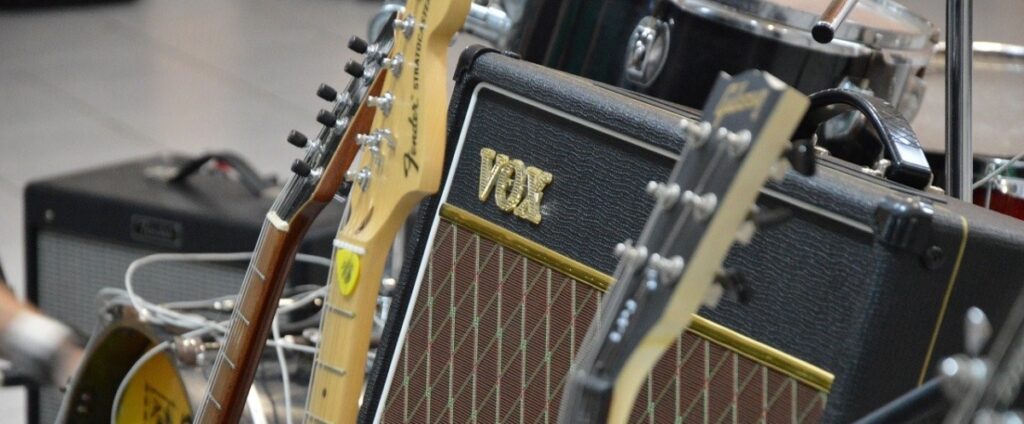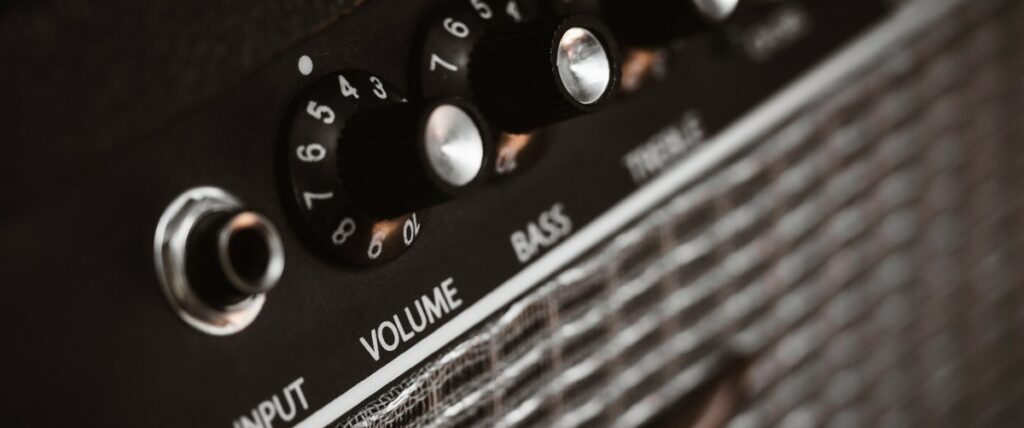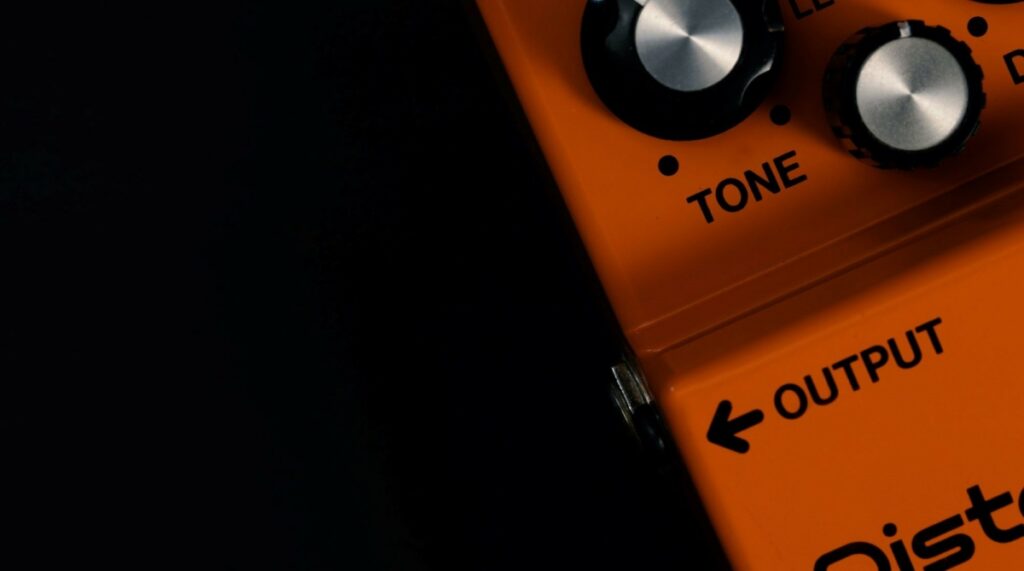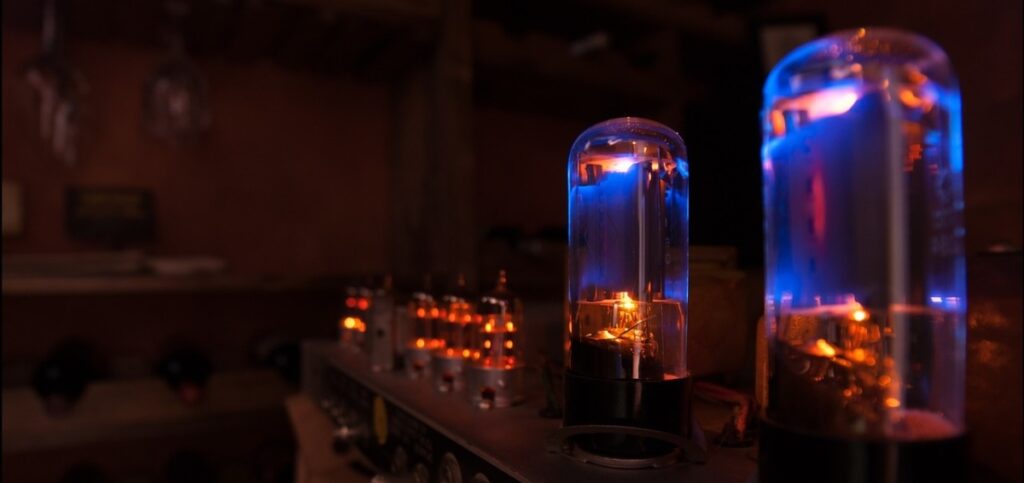One of the biggest issues guitarists have with their amplifiers is a muddy and muffled tone, especially when using a lot of gain in genres such a rock and metal. In this article I’ll take you through six of the most common reasons why your amp sounds muddy and how to fix them:
- Poor Amp Placement
- Bad EQ Settings
- Too Much Gain
- Faults on the Amp
- Pickups are too high up
- Cabinet is Too Large
Cause: Poor Amp Placement
Fix: Use an Amp Stand
Most guitarists will just park their amps on the floor when practicing at home, however this is not the best position if you want the best tone.
Having your amp on the floor will mean you lose a lot of the treble (which provides brightness and clarity) as these frequencies are the weakest so find it difficult to reach your ears before they get lost.
Instead, use an amp stand to raise the amp up, and angle it towards you so you hear more of the treble. It also stops vibrations being transmitted through the floor which causes muddiness.
Check out this amp stand on Amazon for a great value option.

Cause: Bad EQ Settings
Fix: Increase Treble and Decrease Bass
One of the main causes of a muddy sounding amp are the EQ settings. The EQ section of a guitar amp adjusts the shape of the tone and is typically split into the following individual controls:
- Bass
- Mids
- Treble
The bass control adjusts the low-end frequencies. Turning it up will make the tone fuller and warmer, but having it too high can cause the tone to be too muddy. If you are having trouble with a muddy tone, then try dialling back the bass control.
The treble control adjusts the high-end frequencies. Turning it up will make the tone more crisp, clear and bright, hence can counteract the muddiness by giving the tone some more definition.
In some cases, the amp may not have individual bass, mids and treble controls. And in this case, you are usually left with a single “tone” or “EQ” control. Turning this up (clockwise) will usually increase the treble and decrease the bass, so has the same effect of providing clarity and reducing muddiness.
If your amp has different controls (e.g. presence, contour, etc.) then I’d recommend checking out the relevant article below for more help:
- Fender Amp Settings
- Marshall Amp Settings
- Boss Amp Settings
- Orange Amp Settings
- Line 6 Amp Settings
- Vox Amp Settings

Cause: Too Much Gain
Fix: Decrease the Gain or Use a Pedal
Another very common cause of a muddy tone is too much gain. Some amps sound great when you crank the gain, others don’t as much.
If you are using a tube amp, then try turning the pre-amp gain down and the master control up. However, if you are still finding that you need more distortion, but turning the gain up is causing the tone to sound too muddy, then try using a distortion effects pedal.
In a lot of cases, this will allow you to achieve that super saturated metal tone, but without it sounding muffled and messy. Some of my favourite distortion pedals are:
- Boss DS-1 Distortion (Amazon link)
- Pro Co RAT2 (Amazon link)
Check out this guide to using a distortion pedal for more information.

Cause: A Fault on the Amp
Fix: Check the Tubes and Connections
If your amp never usually sounds muddy, and all of a sudden is sounding super muffled, then the chances are that there is a fault that needs diagnosing and rectifying. Typically these faults are on tube (valve) amps and could be due to:
- Loose Input Jack: make sure you first check this as it is a common cause and the easiest to fix. You should also make sure you are using good quality cables.
- Faulty Tube: you can test this by swapping each individual tube with a spare to see if this fixes the issue. The amp must always be turned off before doing this and you should not attempt it unless you are confident you know what you’re doing.
- Loose Connection: this is usually between the speaker and the amplifier which can lead to interference. Usually, the wire will need replacing.
It’s always best to take your amp to a professional technician rather than attempting repairs on your own if you are not confident as it can be dangerous.
Note: this issue is common on tube amps and not solid-state amps.

Cause: Pickups are Too High
Fix: Lower the Pickups
The height your pickups are set to on your guitar influences the tone. Having the pickups too high can cause it to sound muddy, so if you have tried everything else then lowering them is a good option to try. Keep in mind though, that lowering the pickups will make the tone brighter, but also quieter.
In most causes, the pickups should be roughly a 1/8″ distance from the low E string, and 1/16″ distance from the high E string (so set at a slight angle).
Most pickups have two screws on either side which allows you to adjust the height.
- If the pickup has screws which mount it directly onto the body – turn the screws clockwise to lower them
- If the pickup has pickup rings/ surrounds – turn the screws counter-clockwise to lower them

Cause: The Amp Cabinet is Too Large
Fix: Switch to a Smaller Cabinet
Guitar amp cabinets come in various sizes, with the most common being (from smallest to largest):
- 1×8
- 1×10
- 1×12
- 2×12
- 4×12
The larger the cabinet (speaker) is, the warmer, fuller, and louder the tone will be.
Using a larger amp speaker typically results in more low-end bass frequencies being emphasised so produce a warmer and fuller sound in comparison to smaller speakers. Smaller speakers on the other hand, sound more focused and brighter, since they produce less bass.
Having a larger cabinet can in some cases make the tone sound more muddy, especially if the room size does not warrant having a large speaker.
If you switch cabinet sizes you will definitely notice the difference. Check out this comparison.
I would consider this option a last resort if you really aren’t a fan of how a larger cabinet sounds, and you may just need to go ahead and try a different amp entirely to get the tone you’re looking for. Check out these articles for more information:
